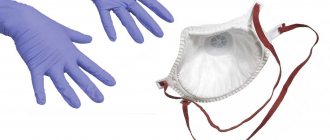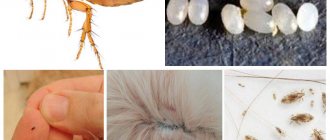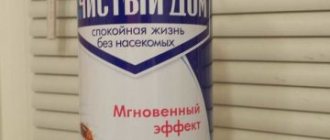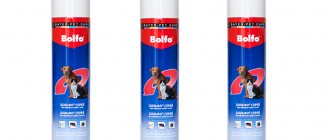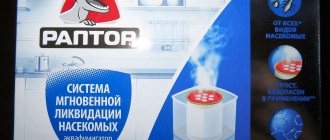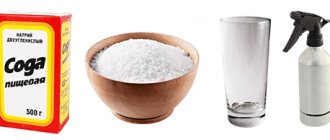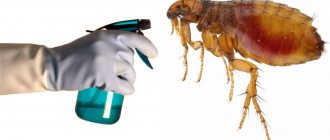Fleas can appear not only on cats and dogs walking outside. Pets that have never left the apartment are also susceptible to infection with parasites.
Moreover, even in a house where there are no animals at all, these small blood-sucking insects sometimes appear. To kill fleas, it is convenient to use special preparations in the form of sprays.
Characteristics of insecticides
All existing flea sprays contain two types of active ingredients:
- repellents – repelling fleas and protecting against their reappearance;
- insecticides - killing bloodsuckers.
Insecticidal sprays usually contain from 1 to 3 active substances with different characteristics. The most common insecticides:
- fipronil - blocks the transmission of nerve impulses, as a result of which insects cannot breathe, eat, move and die;
- pyrethrin - a natural insecticide (extract from Caucasian or Dalmatian chamomile flowers);
- pyrethroids (permethrin, deltamethrin, tetramethrin, cypermethrin) – synthetic analogues of pyrethrin for intestinal and contact action;
- neonicatinoids (for example, imidacloprid) - disrupt the functioning of receptors, cause paralysis and death of parasites;
- organophosphates (dichlorvos, karbofos) are the most highly toxic substances from the entire list.
Flea remedies
When choosing a drug, you need to carefully study its composition in order to carry out the treatment correctly and avoid the occurrence of health problems.
Why are fleas dangerous?
Fleas are blood-sucking insects. The size of adult individuals does not exceed a few millimeters. A feature of fleas is their rapid reproduction - every day, the female lays up to 40 eggs, which form a larva after a week and a half.
The latter is not a full-fledged parasite, but it actively moves, feeds on organic matter, goes through 3 molting cycles, and then pupates. An adult individual emerges from the cocoon, capable of further reproduction.
Several insects that enter a room create a large colony over a short period of time, parasitize domestic animals, and can bite people.
A flea bite causes discomfort and provokes the development of the following problems:
- Diseases. Fleas are carriers of pathogens such as tularemia, salmonellosis, listeria, typhus, certain viral diseases and helminthic infestations.
- Damage to the skin. Bites provoke the development of suppuration and local secondary bacterial infections.
- Allergy. In some people and animals, fleas cause a strong immune reaction in the body, including the development of anaphylactic shock.
We need to have time to protect ourselves from fleas and destroy them in a timely manner.
Requirements for flea spray
Treating your home against insects must be effective and as safe as possible, therefore strict requirements are imposed on flea aerosols:
- versatility - the spray should contain active substances that work not only against fleas, but also against other insects that exist near humans (cockroaches, flies, bed bugs);
- complex effect (it is desirable that the drug not only kills insects, but also has a repellent effect, that is, scares them away, preventing re-infection).
The cost-effectiveness of the product is also important. It is desirable that the concentration of active substances in the aerosol is high enough and one or two bottles (depending on the area of the room) are enough to obtain the result.
Advantages of sprays
Compared to other forms of insecticidal products, flea sprays have several advantages that make their use more preferable:
- ease of application;
- ease of use - no need to calculate the dosage, mix the components, just press the button and spray the solution;
- the ability to treat even the most inaccessible places;
- efficiency - thanks to the combined composition, sprays are more effective than many other products;
- quick results;
- prolonged action.
In addition, modern aerosol flea treatments do not leave stains or smudges on textiles, walls and furniture.
Side effects
If used incorrectly, anti-flea spray for cats can cause intoxication in your pet. Poisoning occurs when particles of the sprayed product are inhaled, when they fall on the mucous membranes or penetrate the stomach.
In this case, the animal may experience:
- Vomit.
- Loss of appetite.
- Drowsiness.
- Weakness.
- Diarrhea.
- Deterioration in the quality or loss of the cat's fur.
- Loss of coordination.
- Allergic manifestations in the form of rash, itching.
Anti-parasite sprays for cats, unlike other products, can be used even in areas heavily infested with fleas. They quickly and effectively deal with insects without requiring re-application.
The disadvantage of this group of drugs is the toxicity of the mixture, which makes their use inappropriate for prophylactic purposes.
Options for choosing a spray
When choosing a flea remedy, you need to pay attention to several important points:
- safety of the drug for people and pets;
- content of highly toxic substances in the solution (permissible only for professional pest control products);
- method of application and mechanism of action on insects;
- cost (it is advisable to choose products from the middle price category, the cheapest ones may be of low quality, and the most expensive ones are often unreasonably inflated);
- manufacturer (you need to choose drugs only from a well-known manufacturer with a good reputation).
You need to choose a means based on what result you want to achieve. If parasites bother you at home, household insect repellents (Kombat, Raid) are suitable. If you need to protect yourself from attacks by bloodsuckers on the street, you should choose, for example, Reftamid Maximum, which protects against midges, ticks and mosquitoes.
How fleas get indoors
Ectoparasites penetrate private houses and apartments in the following ways:
- Walking pets. If a four-legged pet regularly visits the street, then fleas that live on the ground, grass, and other animals penetrate its skin and fur;
- Accommodation on the first floors of buildings. If there is a nearby basement, front garden, or vegetable garden, there is a possibility of direct flea infestation through the balcony, window frames, and doors;
- Transit through outerwear and shoes. Ectoparasites enter a room by clinging to a person’s outer clothing and shoes.
Types of sprays
Sprays are distinguished by the effect they have on insects:
- instant - parasites die almost immediately after treating the room or animal;
- prolonged – the impact continues for a long time, contributing to the destruction of the entire population;
- barrier - after treating the room, insects cannot penetrate it.
For indoors
There are different types of aerosols according to their purpose:
- for processing an apartment or house;
- for the treatment and prevention of infection in animals;
- for human protection.
Depending on the purpose for which the spray is intended, its composition and concentration of active and auxiliary substances change.
Fleas for cats and dogs
Veterinary pharmacies offer a wide range of flea sprays for animals. The preparations contain various combinations of active substances. You can choose a product for a specific category of animals (for example, cats, dogs, rabbits), for different ages. There are specialized medications for very small animals, pregnant and lactating, elderly and weakened animals.
In addition, there are broad-spectrum drugs that help get rid of not only blood-sucking insects, but also ticks and helminths.
For people
Aerosol is the most convenient form for protecting humans from insects. Sprays repel insects, protecting people from bites, and are used not only outdoors, but also indoors. Flea spray for people can also be used to treat clothing if parasites are found indoors. These products contain insecticides that are safe for humans, so they can be sprayed directly onto the skin and hair (avoiding the eyes, nose and mouth).
The vast majority of sprays have a complex effect and protect against several types of blood-sucking insects, as well as ticks. Before using flea spray on humans, you need to make sure that there is no allergic reaction to it. To do this, spray a little of the drug on your wrist or elbow and wait a little. If the skin becomes red or itchy, the product is not suitable.
For cleaning rooms
Many manufacturers produce flea aerosols that can be used in an apartment or house. During application, you need to remember that spraying the solution into the air is ineffective. It must be applied to furniture, textiles, floors - anywhere where insects can live. Use indoor flea spray once. If it was not possible to get rid of the insects immediately, you can re-treat after 2 weeks.
Since the concentration of toxic substances in indoor products is much higher than in preparations for animals, using them to treat pets against fleas is strictly prohibited. This can cause serious poisoning.
Popular questions
Can spray products be used indoors on clothing? It is not recommended to use them for processing things. However, there are aerosols that have a particularly mild effect, for example, Reid, Raptor. Since they do not contain highly toxic components, they can be used to treat clothing.
How to choose a spray to remove fleas from cats and dogs? The aerosol should be selected according to the age characteristics of the animal, species, and breed. To prevent harm to your pet’s health, it is recommended to first consult with a specialist.
How often should a room be sprayed? The frequency of procedures depends entirely on a number of aspects. For example, if you have animals with access to the street, it is recommended to use the spray at least once every two weeks. If the risk of fleas is minimal, insecticides should be used as needed.
How to use aerosols correctly?
Before you start treating premises or animals with flea spray, you must carefully read the instructions for use. There are several rules by following which you can get the maximum effect from using anti-flea drugs:
- Before using the aerosol to treat an animal, it must be covered with a protective collar to prevent the solution from getting into the eyes, nose and mouth. The collar should remain on the pet for a while to prevent him from licking off the medicine.
- Before using the spray to treat premises against fleas, it is necessary to carry out wet cleaning, get rid of dust, wash textiles, clean upholstered furniture and carpets.
- When carrying out treatment, you must carefully spray all hard-to-reach places where insects can nest - baseboards, cracks, the space behind cabinets and other furniture, ventilation holes.
- After the room has been treated, it is left closed for 2-3 hours and then ventilated properly.
Premises treatment
If fleas have infested the basement of a house, and residents of many apartments suffer from them, a safer and more effective solution would be to call a special service, whose employees will treat the basement and affected apartments with professional means.
Habitat and breeding environment for fleas
In order to properly treat a room against fleas, you need to know the places where sanitization should be carried out and take into account the development cycle of insects.
Fleas are blood-sucking parasites that feed exclusively on the blood of animals and birds, and sometimes humans. When they bite, they pierce the skin, introducing an enzyme that reduces blood clotting, so that they can then freely suck it out through the proboscis.
The flea's life cycle does not only take place in the animal's fur. The main habitat of the insect is the lower part of the room: the floor and cracks, dusty and cluttered places at a height of up to 1 m, soft-pile carpets and other floor coverings, the lower parts of furniture.
Interesting!
Many people think that fleas will disappear on their own with the arrival of winter. However, it is not. The activity of parasites in cold weather decreases only on the street, and when settled in a warm room, they do not depend on the season and reproduce quite safely, finding food for themselves on the skin of domestic animals or humans.
Flea eggs usually accumulate on the floor, brought accidentally into the house or falling from the fur of pets, only to transform first into a larva and then degenerate into an adult “bloodthirsty” flea.
Therefore, to remove fleas from a house or apartment, in addition to treating animals, you should take care of an effective method and means of destroying adult “bloodsuckers” and their eggs indoors.
Protective measures for humans when using insecticide
The active ingredients in flea sprays used to treat an apartment or pet are toxic, moderately dangerous substances. If used incorrectly, they can cause deterioration in health, poisoning and other unpleasant consequences.
To avoid this when using insecticides, you must follow safety precautions:
- do not forget about personal protective equipment - wear a mask or respirator, gloves, and if the room is treated with professional means, then you should dress so that there are no exposed skin areas;
- after spraying, thoroughly wash your hands, face, and rinse your mouth;
- there should be no one in the room being treated - no household members, no pets;
- while spraying the product, smoking, drinking or eating is strictly prohibited;
- If the drug gets into your eyes or skin, rinse it off immediately with plenty of clean, cool water.
And one more important rule - spray bottles cannot be disassembled or attempted to be reused for household purposes; they must be disposed of immediately after the processing procedure is completed.
